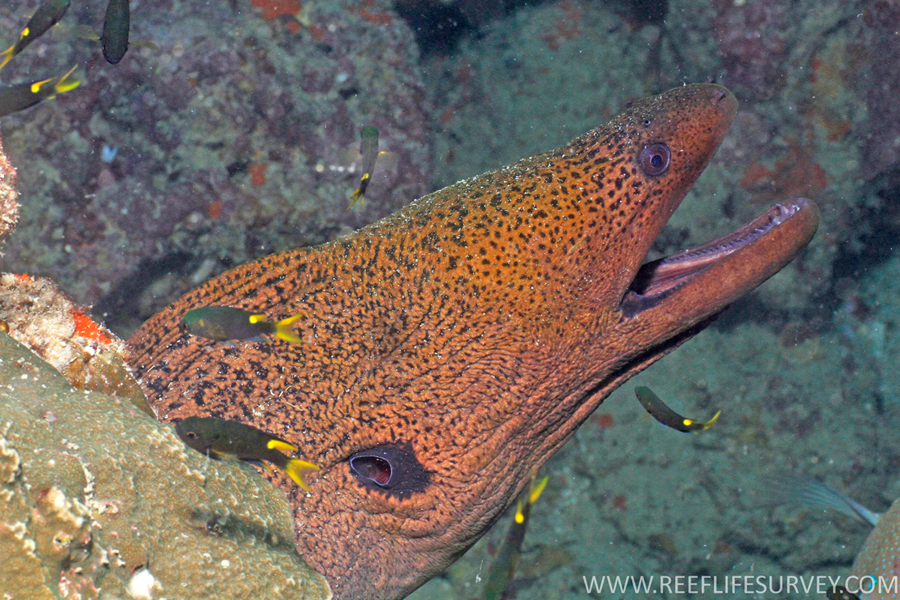Giant Moray, Gymnothorax javanicus (Bleeker 1859)

A Giant Moray, Gymnothorax javanicus (with Yellowtail Demoiselles, Neopomacentrus azysron), on the Great Barrier Reef, Queensland. Source: Graham Edgar / Reef Life Survey. License: CC by Attribution
Summary:
A common brown moray with a large black blotch surrounding the gill opening and black speckles on the head that resemble leopard spots further back on the body. Juveniles are tan with numerous large black spots.
The Giant Moray is the largest moray eel species in the Indo-Pacific. These morays may be dangerous if provoked, and the species has been implicated in attacks on humans. Large individuals may also cause ciguatera poisoning.
Video of a Giant Moray attacking and eventually swallowing a stonefish in the Red Sea, 2007.
Video of a battle between a Banded Moray and Giant Moray
Video of a Giant Moray at a cleaning station in the Red Sea.
Video of why Giant Morays may be dangerous - not for the squeamish!
The Giant Moray is the largest moray eel species in the Indo-Pacific. These morays may be dangerous if provoked, and the species has been implicated in attacks on humans. Large individuals may also cause ciguatera poisoning.
Video of a Giant Moray attacking and eventually swallowing a stonefish in the Red Sea, 2007.
Video of a battle between a Banded Moray and Giant Moray
Video of a Giant Moray at a cleaning station in the Red Sea.
Video of why Giant Morays may be dangerous - not for the squeamish!
Cite this page as:
Dianne J. Bray, Gymnothorax javanicus in Fishes of Australia, accessed 01 Apr 2025, https://fishesofaustralia.net.au/Home/species/2041
Giant Moray, Gymnothorax javanicus (Bleeker 1859)
More Info
|
Distribution |
Recorded in Australia from about Barrow Island, WA, around the tropical north to Bargara, QLD. Elsewhere, widespread in the Indo-west-central Pacific. |
|
Feeding |
Feeds mostly on fishes. |
|
Remarks |
If provoked, this large powerful moray can a inflict serious injury with its dagger-like teeth. If eaten, large individuals may also cause ciguatera poisoning. |
|
Species Citation |
Muraena javanica Bleeker, 1859, Natuurwetensch. Tijdschr. Nederland. Indië 19: 347. Type locality: Patjitan, Java, Indonesia. |
|
Author |
Dianne J. Bray |
Giant Moray, Gymnothorax javanicus (Bleeker 1859)
References
Allen, G.R. 1997. Marine Fishes of Tropical Australia and South-east Asia. Western Australian Museum. 292 pp.
Allen, G.R. & Erdmann, M.V. 2012. Reef fishes of the East Indies. Perth : Tropical Reef Research 3 vols, 1260 pp.
Allen, G.R. & Smith-Vaniz, W.F. 1994. Fishes of Cocos (Keeling) Islands. Atoll Research Bulletin 412: 1-21.
Allen, G.R. & R. Swainston. 1988. The Marine Fishes of North-Western Australia. A Field Guide for Anglers and Divers. Western Australian Museum. Pp. 201.
Bleeker, P. 1859. Over eenige vischsoorten van de Zuidkust-wateren van Java. Natuurwetenschappelijk Tijdschrift voor Nederlandsch Indië 19: 329-352.
Bohlke, E.B. & J.E. McCosker. 2001. The moray eels of Australia and New Zealand, with the description of two new species (Anguilliformes: Muraenidae). Records of the Australian Museum 53(1): 71-102.
Halstead, B.W. 1980. Dangerous marine animals. Cornell Maritime Press, Inc., Maryland, U.S.A.
Halstead, B.W., P.S. Auerbach & D.R. Campbell. 1990. A colour atlas of dangerous marine animals. Wolfe Medical Publications Ltd, W.S. Cowell Ltd, Ipswich, England. 192 pp.
Kuiter, R.H. 1996. Guide to Sea Fishes of Australia. New Holland. Pp. 433.
Randall, J.E. 1969. How Dangerous is the Moray Eel? Australian Natural History June 1969: 177-182.
Randall, J.E. 1980. A survey of ciguatera at Enewetak and Bikini, Marshall Islands, with notes on the systematics and food habits of ciguatoxic fishes. Fish. Bull. 78: 201-249.
Randall, J.E., Allen, G.R. & R.C. Steene. 1997. Fishes of the Great Barrier Reef and Coral Sea. Crawford House Press. Pp. 557.











